Fishing Lures Types Chart
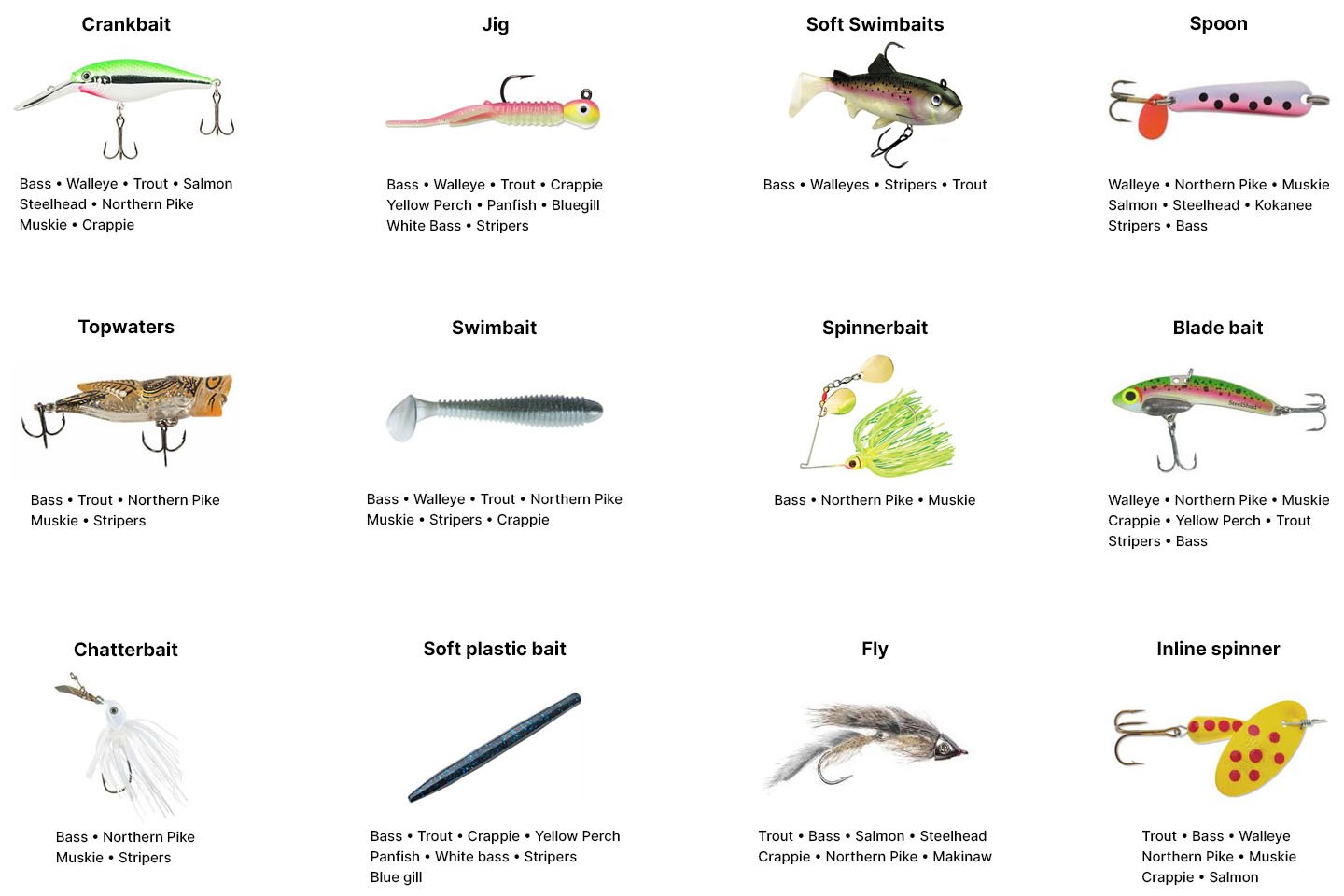
| Lure Type | Fishing Application | Recommended Species |
|---|---|---|
Crankbait/Plug
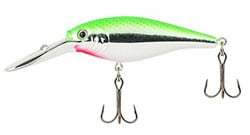
|
Casting, trolling | Bass, Walleye, Trout, Salmon, Steelhead, Northern Pike, Muskie, Crappie |
Jig
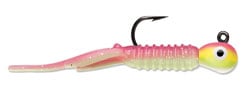
|
Casting, vertical fishing, ice fishing | Bass, Walleye, Trout, Crappie, Yellow Perch, Panfish, Bluegill, White Bass, Stripers |
Inline spinner
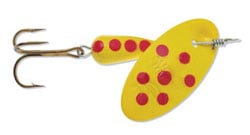
|
Casting, trolling | Trout, Bass, Walleye, Northern Pike, Muskie, Crappie, Salmon |
Spoon
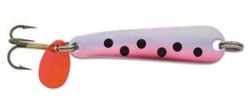
|
Casting, trolling, ice fishing | Walleye, Northern Pike, Muskie, Salmon, Steelhead, Kokanee, Stripers, Bass |
Topwaters
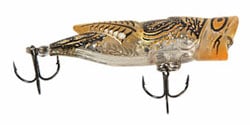
|
Casting | Bass, Trout, Northern Pike, Muskie, Stripers |
Swimbait

|
Casting, trolling, vertical fishing, ice fishing | Bass, Walleye, Trout, Northern Pike, Muskie, Stripers, Crappie |
Soft plastic bait
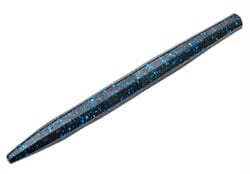
|
Casting, finesse tactics, ultra light fishing | Bass, Trout, Crappie, Yellow Perch, Panfish, White bass, Stripers, Blue gill |
Blade bait
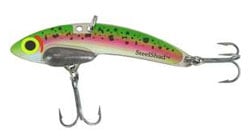
|
Casting, vertical fishing, ice fishing, trolling | Walleye, Northern Pike, Muskie, Crappie, Yellow Perch, Trout, Stripers, Bass |
Spinnerbait

|
Casting | Bass, Northern Pike, Muskie |
Chatterbait
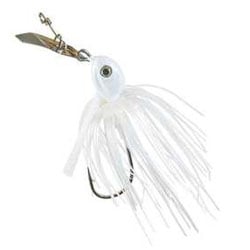 |
Casting | Bass, Northern Pike, Muskie, Stripers |
Fly
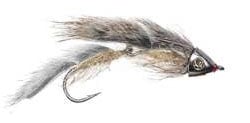
|
Fly fishing, casting, finesse tactics, ultra light fishing, trolling | Trout, Bass, Salmon, Steelhead, Crappie, Northern Pike, Makinaw |
Crankbait/Plug

A crankbait often referred to as a “plug” is a hard-bodied casting lure that features an extended bill on the line side end of the lure, with two or three sets of trailing treble hooks beneath the body.
The length of the bill determines the depth this lure works at. The more aggressive the bill, the deeper it will dive. The width of the bill determines how easily you can move the lure side-to-side on retrieves.
This style of lure is great for walleye, perch, bass, lake trout, and Northern pike that hover at depths from two to 20 feet below the surface.
Types of Crankbait/Plugs
| Lipless Crankbait | Most versatile. Dives based on rate of retrieval. Can be fished at any depth. Does well in grass |
| Square Billed Crankbait | Square bills are fished in and around cover in shallow water near heavy cover. 2' to 8' dive depth |
| Round Billed Crankbait | Medium to deep diving crankbait. Average 10' to 30' dive depth |
Jig

Perhaps the simplest design, but also one of the most effective lures for a wide variety of game fish. A jig is a single hook with a round, or sometimes fish-head-shaped lead head poured around the eye of the hook. These can be the natural grey color of the lead, black, white, or a wide variety of colors. Some have “eyes” painted on each side to resemble baitfish.
A plastic or rubber minnow, squid, frog, or other aquatic creature is threaded onto the jig. This produces a lure resembling a baitfish that attracts hungry trout, walleye, perch, and crappie.
To use a jig, cast near known underwater structure, or in the flow of an incoming stream and work the jig with short jerks of the rod while slowly reeling in your line. The jerk works the jig up and down as it approaches shore in the manner of a baitfish trying to elude predators.
Types of Jigs
| Swim Jigs | Range from 1/4 to 1/2 oz. Have light weed guard, with bullet-shaped head to speed through cover. |
| Casting Jigs | Range from 3/8 to 1/2 oz. Have a flat-bottom head. Multi-purpose jig to be used with wire weed guard and casting jig trailers (creatures, craws, grubs). |
| Flipping Jigs | Ideal for thick weeds. Should be 3/8 to 1oz, have heavy gauge hook, with firm weed guard. Can be used with jig trailers (creatures, craws, grubs). |
| Grass Jigs | 1/4 to 1 1/2 oz. with conical head with line tie at the top of the head. Use compact jig trailers. Ideal for penetrating heavy grass. |
| Football Jigs | Designed to drag along rocky bottoms without catching. Should have 3/8 to 1 oz head, wide gap hook, and full skirt. Weed guard optional. |
| Finesse Jigs | Ideal for targeting smaller, cold water fishing in areas with high fishing pressure. Recommended 3/16 to 1/4 ounces. Compact, ball shaped head with finesse skirts and light wire hook. |
Inline Spinner

Many anglers consider the spinner the ultimate lure for trout. It is an excellent choice for rivers, streams, lakes, and ponds, just about anywhere you can find trout. A spinner gets its name from the blade at the front of the lure that spins when you retrieve your line. The spinning action catches light which attracts the attention of fish. A blade, depending on the design, can also produce sonic vibrations similar to swimming baitfish that also attract fish.
A spinner is among the easiest lures to use. Just cast and retrieve, you don’t need to jerk the rod, or flip it up or down, just turn the handle on your reel and let the lure do its work. You can adjust the depth of the spinner by slowing down your retrieve for deeper use or cranking faster to keep the lure at shallower depths.
This is a top trout lure, but it will work for walleye, largemouth bass, and Northern pike as well.
View SpinnersSpoon

A spoon gets its name from the spoon-shaped appearance of the lure. This is the simplest lure you can use since it has no moving parts. A treble hook is attached to the end of the spoon and a snap-swivel on the other.
You can tie your line directly to the spoon, but this will twist your line creating snarls in the line after extended use and lowering the effectiveness of the spoon to spin in the water. A snap-swivel allows the spoon to spin in the water without twisting the line.
A spoon works by catching light which attracts fish. It is best in bright conditions where the dappling on the surface of a gold or silver spoon can reflect light. Spoons are often colored in solid green, orange, or red to enhance visibility, and they’re also often colored to resemble minnows, frogs, or squid. This is a great lure for trout, walleye, pike, and even walleye in the right conditions.
Types of Spoons
| Weedless Spoons | Range from 1/4 oz. to 11/8 oz. Ideal for fishing thick weeds and cover. Have a single hook with optional wire guard to prevent snags. |
| Casting Spoons | Produce back and forth wobble. Range from 1/36 oz. for small panfish to 3 oz. for pike, muskies and lake trout. Uses single or treble hook. |
| Trolling | Thinner profile than casting spoons. Product fluttering action. Typical weight is around 1/8 oz. Great lure for walleye, trout, and salmon fishing. |
| Surface Spoons | Floats with its hook pointing upward to prevent snags. Fished over thick vegetation. Typically made of plastic and has extra attractors. |
| Jigging Spoons | Ideal for vertical jigging in deep water. Thick, heavy and flat. Effective for bass and walleye. |
Topwaters

If you’re a bass fisherman, this is a must have lure. A topwater lure is the most exciting lure you can throw at a largemouth bass. When they hit this lure, the water boils, and the action begins with all the subtlety of a runaway freight train.
Topwater lures float. They simulate a frog, mouse, snake, or large insect skimming the surface of the water and attract bass from the weeds below the surface. The concave face of some topwater lures works to push the water ahead creating waves similar to those produced by swimming bait.
To use a topwater lure you have to make an accurate cast near cattails, willows, lily pads, or overhanging brush. Often you’ll get a strike as soon as the lure hits the water, but jerking the popper a few feet, reeling in line, then jerking again extends the attraction on each cast. This is a fabulous bass lure.
Types of Topwaters
| Poppers | Have a concave mouth with narrow tail. Ideal for fishing bass in small areas near cover. |
| Walkers | Produces a back-and-forth or zig-zag action along the surface as it is retrieved . Ideal for covering lots of water. |
| Wakebaits | Have a sharp angled lip similar to a crankbait. Shimmies back and forth along the surface as retrieved. Produces a V shaped wake that attracts fish. |
| Minnows / Twitch baits | Floating jerkbait. Ideal for clear lakes with high fishing pressure or in small areas where bass are present. |
| Buzzbaits | Have a lead head with skirt and arm that extends up over the skirted head with a spinning prop blade. Best fished along banks, sparse grass and cover. |
| Prop baits | Produce a lot of action without moving very far. Ideal for bluegill fishing and targeting bass in shaded areas. |
| Frogs | Ideal for targeting bass in heavy vegetation and around cover. Resembles a twitching frog on the water's surface. |
Swimbait

Swimbaits are used in cast and retrieve or trolling for a variety of game fish. They’ll work for trout, bass, walleye, perch, and crappie. A swimbait resembles a swimming baitfish, hence its name.
These are plastic or rubber lures that are slipped over a jig or larger standard-sized hook. They are designed to create natural motion with a trailing flap that creates the impression of a baitfish’s tail working the water.
Swimbaits can be retrieved similarly to spinners, with just a cast and slow crank in fast-moving water, or a faster retrieve on a still pond or lake. They work well on a slow troll that allows the swimbait to work at a specific depth.
Types of Swimbait
| Hard-body | Include multi joint, single joint and glide baits. Provide a very lifelike appearance and action. Ideal for fishing large bass and predatory fish. |
| Soft-body | Include fully body, line through, and top hook baits. Heavy, solid-rubber lures. Provide more realistic feel in the mouth when taken by a bass. |
| Paddle tail | Include boot tail and wedge tail baits with hollow or solid body. Solid body tends to have lower hookset rate by is more durable. Ideal for fishing heavy weeds when rigged weedless. |
Soft Plastic Bait

Originally, soft plastic bait was referred to as a rubber worm and was available in every color as long as that color was black. They still caught substantial numbers of large and smallmouth bass, but the modern plastic bait has evolved into a rainbow of colors and shapes.
The original rubber worm style is connected to a couple of standard hooks with a short line tied between the hooks. The plastic bait is hooked near the head and in the middle so a trailing tail is free to work in the water. This creates the impression of a large nightcrawler or snake swimming in the water.
To use a soft plastic bait, cast it into open water and let it sink for a few seconds. Jerk lightly and retrieve in still water. In slow-moving water, you can jerk lightly then allow the current to pull the line tight, then jerk again. This stationary jerking motion is a natural way to present bait suspended in thermal layers of water.
Types of Soft Plastic Bait
| Finesse worm | Essential for fishing clear water or tough conditions. Can elicit strikes from uninterested fish during high pressure. |
| Creature baits | Mimic specific types of animals including salamanders, lizards, and frogs. Have several appendages. Ideal for targeting bass in heavy cover. |
| Tubes | Can mimic baitfish or crawfish. Extremely versatile and great for bass fishing. Produce an erratic spiral ideal for sight fishing. |
| Craws | Mimic the appearance and action of a crawfish. Ideal for bass fishing in waters where crawfish are present. |
| Stick bait | Versatile soft plastic bait ideal for targeting smallmouth and largemouth bass. |
| Toads | Soft plastic frog imitators designed to be fished over matted vegetation or grass. Use with an offset worm hook or double pronged toad hook. |
| Trailers | Designed to be fished with casting jigs, swim jigs, and spinnerbaits. Provide a undulating motion when attached to lures. |
| Shat tails | When rigged on a extra wide gap (EWG) hook can be made to move like an injured baitfish upon retrieval. Excellent bass fishing lure. |
Blade Bait

These are sometimes referred to as “lipless” crankbaits, but their design is re intricate than that. Blade Baits are made with the head of the lure wider than the tail, the resulting vibrations attract fish and are especially effective in fishing for smallmouth, largemouth, white and striped bass.
Most models are solid, so they sink rapidly, but some come with additional rattling “BBs” or other metal inside. When the lure moves in the water these bits of metal vibrate, creating noise that can attract fish.
This is an easy lure to fish since it only requires a constant retrieval rate. You can jerk and pop ta blade bait for more action, but the retrieve is often enough. These are painted to match minnows, sunfish fry, or bluegill fry, matching these popular baitfish.
View Blade BaitsSpinnerbait

Spinnerbait is different than an inline spinner in the size and design of the blade. A spinnerbait can be a solid gold or silver color, but most have different colored bodies that create the illusion of a baitfish’s pattern when the blade is spinning.
The blade on a spinnerbait often spins wider, with more resistance than an inline spinner, creating more noise and a harder retrieve. These are often larger than an inline spinner as well, with some models in sizes four and up weighing almost an ounce.
A spinnerbait can be fished via casting from shore, or in trolling. They’re great for a variety of fish but very effective for all species of trout. You can get walleye and perch to strike on these as well.
Types of Spinnerbait
| In-line spinner | Can be cast or trolled behind moving boats. Ideal for targeting trout, panfish, muskies and smaller salmon species. Multispecies lure. |
| Safety pin | Ideal for targeting bass, northern pike and redfish. Can be used to cover the entire water column, but typically fished near the surface. |
Chatterbait

At first glance, you won’t notice much difference between a chatterbait and a buzzbait. They’re both considered combination lures that combine the best of spinners, poppers, and jigs into one cohesive package.
A chatterbait is used in deeper water than a buzzbait, which is a topwater lure. A chatterbait provides a multi-sensory approach to catching walleye, bass, perch, pike, and trout by catching the light with its spinning blade, and producing a sonic vibration in the process.
The hooded, feathered cover around the hook helps in reducing weeds on the hook, and the jig head provides the control and action of jigging with the attraction of a spinning blade. This lure works well from a dock, streamside, or in trolling.
Fly

Dry flies, wet flies, streamers, they’re all names of a variety of lures that often border on a cult for some anglers. A fly is a hook, usually a smaller size 10 or less with feathers, and other natural material tied to it that makes it resemble an insect, larvae, or even floating egg sacks.
This is among the most popular lures in the world and the variety is nearly limitless in color, design, and presentation. A dry fly will float on the water like a roosting insect, while a wet fly floats just below the surface, resembling the larvae of newly hatched insects. Effective fly fishing requires the fly to match the hatch of insects hovering above the water, or their larvae floating just below the surface.
While trout fishing is the main species sought by fly fishermen, bass, and other surface-feeding freshwater fish are equally attracted to a fly. There are even saltwater enthusiasts who use larger streamers on a fly rod to attract shallow water species.
Types of Flys
| Dry flies | Mimic adult aquatic insects. Fished on the surface. Ideal for targeting trout, panfish, and bass. |
| Nymphs | Imitate young aquatic insects in their larval stage. Are fished near the bottom of lakes and rivers. Effective for targeting trout, steelhead, salmon, and panfish. |
| Streamers | Imitate baitfish, crawfish, and leeches. Streamers are fished under the surface throughout the water column. Can be used in rivers and lakes. Multi species lure. |
| Wet flies | Imitate aquatic insects as they swim through the water column toward the surface. Effective for catching trout, steelhead, bass, salmon, and panfish. |
| Salmon flies | For targeting Atlantic and Pacific salmon. Can also be used for fishing steelhead. Are designed to trigger a an aggressive response. Do not imitate any specific creature or insect. |
| Saltwater flies | Flies using patterns and designs that mimic food sources found in the ocean. Common saltwater flies will mimic shrimp, crab, and other crustaceans. Multi species flies. Commonly used for targeting bonefish and tarpon. |